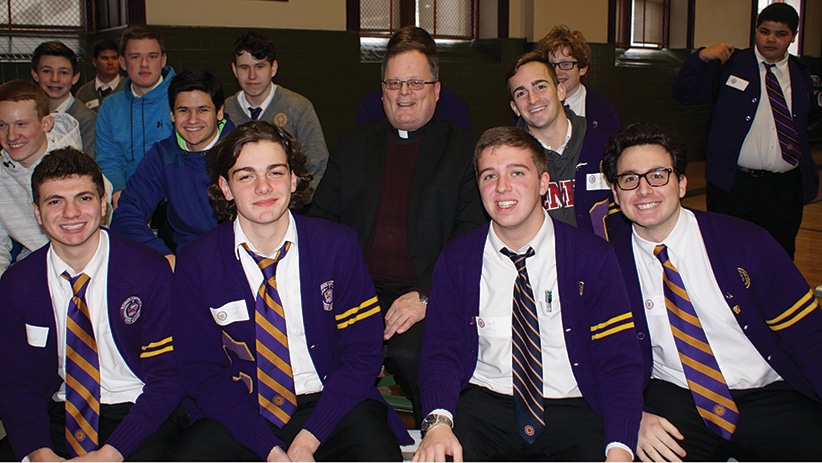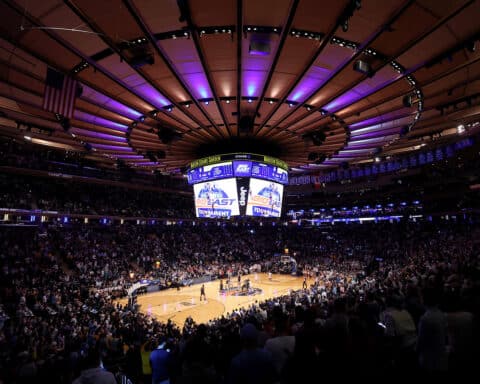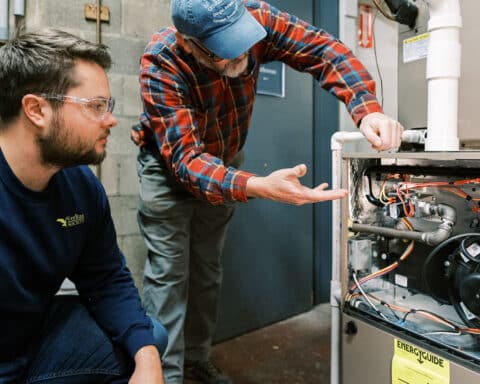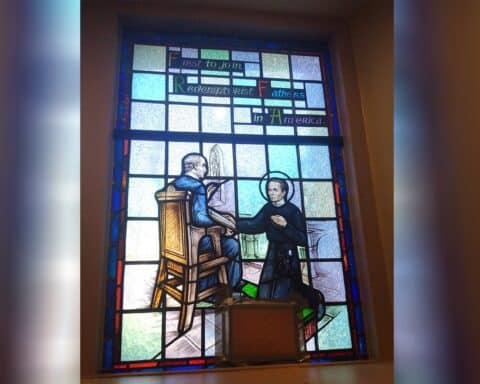When students at Roman Catholic High School learn about American history, they may as well be taking a course on their own school’s heritage.
Civil War veterans built Roman Catholic High School, which was the first diocesan Catholic high school in the United States when the building opened in 1890 at the intersection of Broad and Vine streets, a location that was then on the outskirts of Philadelphia.
Many of the all-boys high school’s first graduates fought in the Spanish-American War. The school’s basketball team integrated in 1902, breaking the color barrier several decades before Major League Baseball and the National Basketball Association.
In 1952, President Harry Truman appointed James Patrick McGranery, a Roman Catholic alumnus, to be the country’s 61st U.S. Attorney General. McGranery wrote the federal government’s amicus brief in Brown v. Board of Education that called for an end to segregating public schools.
“There’s really some neat history here,” said Father Joseph Bongard, the president and rector of Roman Catholic High School, who graduated from the school in 1977.
Thriving and expanding
In a time when much of the national discussion on Catholic education focuses on dioceses that are struggling to keep their schools open and affordable for families, Roman Catholic High School remains as vibrant as it was in the late 19th century, and it is looking to expand.
“When the narrative is so often about closures, mergers and consolidation, here is literally the first Catholic high school in the country and we’re still here,” Father Bongard told Our Sunday Visitor.
Roman Catholic is in the midst of an ambitious $25 million expansion campaign, officially known as “A Vision of Promise.” This year, the school community will celebrate the first phase of that campaign with the opening of the Howard Center for the Arts, a new building that will host music, theater and art programs.
Father Bongard said Roman Catholic is also raising money for a new STEM Center that will house additional classrooms for science, engineering and math courses, as well as long-distance learning labs and interactive science laboratories.
The school is also looking to build a 1,200-seat fieldhouse for assemblies and the school’s nationally ranked basketball team, which has to play in local college gymnasiums because Roman Catholic’s small gym was built one year before James Naismith invented basketball.
“We have some big plans,” Father Bongard said.
Connected to history
Roman Catholic’s history and location, in what is today a busy downtown intersection, provides unique educational opportunities for the roughly 1,000 boys who attend from 92 different zip codes in and around Philadelphia.
Students in an advanced placement history class last year conducted a research project on the Roman Catholic alumni who received medals from the French and British governments for their service in World War I.
Also in 2017, when the national discussion on race relations was marked by acrimony and bitterness, the Roman Catholic community organized an assembly to commemorate the 115th anniversary of the 1902 basketball team’s integration.
Descendents of that team’s coach, Billy Markward; the school’s first black basketball player, Johnny Lee; and Lee’s teammates reflected on that significant moment in Roman Catholic’s history. The decision to integrate the team was not without controversy. The school’s athletic league notified Roman Catholic in a letter that other schools would refuse to play against the team. The coach called a meeting, at which point the team captain stood up and said, “If Johnny doesn’t play, we’re not playing.” The school stood with Lee, whose father had been a slave, and the league backed down.
“The team stuck together,” Father Bongard said.
Roman Catholic’s history cultivates a sense of pride and fraternity in the student body. Last year, students sang “Happy Birthday” to an alumnus who turned 100 years old and regaled them with stories from when he attended the school.
“One of the things that really does resonate with them is the history,” Father Bongard said. “I think in many ways it’s because their lives are so uncertain in so many different ways, and here they’re part of something that’s been here for 128 years.”
Rising from the ashes
Roman Catholic was founded by Thomas E. Cahill, a 19th- century Philadelphia merchant whose life was the “quintessential American story,” Father Bongard said.
Cahill’s parents, immigrants from Ireland, sent him to work shortly after he finished sixth grade. Despite his relative lack of a formal education, Cahill was a prodigy who started several successful businesses and had amassed a personal fortune by the time he died in 1878.
In his will, Cahill devoted almost his entire fortune to establish Roman Catholic High School so that no young man would ever be deprived of the formal education he never had. After land was purchased and architects were hired, construction began in 1886. The school opened four years later.
“There is a palpable sense of history here,” Father Bongard said. “But I warn people that a lot of great institutions have great histories, but aren’t here anymore.”
In 1959, a fire destroyed the school’s distinctive dome and forced the building to be closed for repairs. That calamitous event seemed to portend years of decline, as Roman Catholic found itself buffeted by the same choppy winds of socio-economic and demographic change that hit Catholic dioceses across the Midwest and Northeast.
By 1986, an annual deficit of $440,000 and declining enrollment had the Archdiocese of Philadelphia poised to close Roman Catholic, but Philadelphia’s Cardinal John Krol gave the school’s alumni a chance to raise money to close the deficit and rebuild the enrollment. It was the alumni who rose to the challenge, and the school was saved.
“Our alumni are very much committed to what our school is about,” Father Bongard said. “They are a crucial part of all this.”
Forming Christian men
Today’s Roman Catholic students, wearing the school’s distinctive purple sweaters, can be seen walking about downtown Philadelphia, attending classes as well as visiting several nearby museums for class projects.
“We try to exploit where we’re located,” said Father Bongard, who is the only priest on staff at Roman Catholic. That situation is a return to the school’s roots. At its founding, the high school was governed and staffed by laypeople, with a priest as the rector.
Today, Roman Catholic is still staffed by lay teachers — some of whom have taught at the school for more than 40 years — and governed by a board of trustees that includes Catholics, Baptists and Quakers. The Howard Center for the Fine Arts is named for a local Jewish couple that supported Roman Catholic and believed in its mission.
“They liked what we were doing, and they realized the importance of an alternative to public education,” Father Bongard said.
As one of only two all-boys Catholic high schools in the Archdiocese of Philadelphia, Father Bongard said Roman Catholic also provides a venue for boys, who come from various socioeconomic levels and academic backgrounds, to weather the teenage years together.
“We try to take boys and make them into young Christian men,” Father Bongard said. “It’s a very difficult task, but one that we’ve been doing for a long time, and I think in many ways, it’s kind of been working.”





